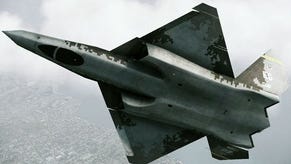Face-Off: SoulCalibur 5
Point and Kilik.
| - | Xbox 360 | PlayStation 3 |
|---|---|---|
| Disc Size | 7.0GB | 7.05GB |
| Install | 7.0GB (optional) | 2153MB (optional) |
| Surround Support | Dolby Digital | Dolby Digital, 5.1LPCM |
Renowned for their intricate detail and heavy effects work, the SoulCalibur and Tekken games are a remarkable example of just how much processing and rendering Namco is able to cram into the tiny window afforded by a solid 60 frames-per-second update. While it's fair to say that the core gameplay in both of these franchises never really changes substantially, the engine powering it definitely does: from a visual perspective, SoulCalibur 4 and Tekken 6 have each evolved in their own way with each new iteration, and it's clear that this new game sees yet another visual leap.
But can the Project Soul development team bring the same level of visual accomplishment to both Xbox 360 and PlayStation 3 versions of the SoulCalibur 5? In Namco's previous fighting games, there's always been a sense that the developers have been testing the graphical capabilities of both consoles, always handing in very close games overall, but often including some intriguing - and often bizarre - differences in the visual feature-set of each version.
It feels as though things have moved on this time around, however. As you'll see from the video below, and the SoulCalibur 5 720p comparison gallery, this game really is gorgeous - and it's equally impressive on both Xbox 360 and PlayStation 3.
"Aside from some insignificant effects differences, only varying anti-aliasing implementations can separate SoulCalibur 5 from an image quality perspective."
If there are any surprises in the comparison, it's that there's so little to tell these two games apart. Previously, the Project Soul team had included a small batch of 360 enhancements that gave the Xbox version of SoulCalibur 4 a marginal visible improvement over its sibling: lens flare and bloom effects were omitted from the PS3 game. There were also curious differences in the setup of the framebuffer itself. Neither game possessed anti-aliasing, but the Xbox 360 game actually ran internally at 1365x768, compared to the native 720p of the PS3 version - an extra 13.8 per cent of resolution. We speculated that by downsampling that back to 720p, Namco was attempting to reduce aliasing via super-sampling, but the effect was not exactly convincing.
After that, Namco's studios experimented still further with Tekken 6, where the developers utilised the same super-sampling approach on 360 while introducing a motion blur option that scaled down resolution while in operation, and redirecting graphical power into blending the characters and introducing better texture filtering - an intriguing example of a sub-HD game presenting more texture detail at 1024x576 than it did at 1365x768. As the blog post also revealed, the PS3 game was locked at 576p in both modes, but MSAA was introduced if motion blur was disabled.
SoulCalibur 5 puts an end to the tinkering and shows us the final product after years of experimentation. Both games operate at native 720p utilising what we suspect are different forms post-process anti-aliasing. In truth, SoulCalibur 5 throws so many effects into the mix that sometimes it's difficult to follow exactly what's going on (particularly when on-screen 3D text can manifest with very obvious aliasing), but this area is one of the few points of differentiation.

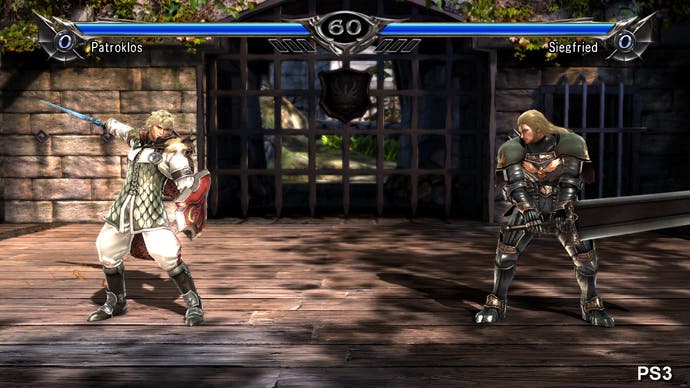
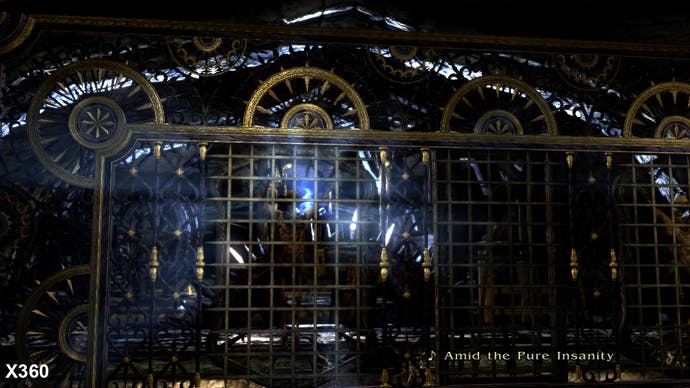

"Lighting and effects work has been taken to the next level with this new SoulCalibur title - one of the most gorgeous 60FPS titles we've seen on current-gen platforms."
Take a look at the images above and see what you think. We'd be inclined to say that the Xbox 360 version is utilising Timothy Lottes' FXAA technology, while PS3 goes for MLAA. In both cases, there's not much of the blurring we typically see associated with post-process AA, suggesting that the edge-detection isn't as aggressive as it is in the other games we've seen using these techniques. As it is, it's difficult to tell the difference during gameplay - running at 60FPS, the smooth movement of the game itself helps to blur and blend the images to the human eye.
Over and above that, while there may be miniscule differences in the implementation of isolated effects, the overall look of the game is extremely similar on both systems. There are no user-selectable options this time around that change the selection of effects employed - they're all enabled by default and they often look quite beautiful. Motion blur is adeptly handled with a lovely camera-based effect that look just as good on PS3 as it does on Xbox 360. Depth of field is employed to give a soft focus to the beautifully rendered environments that are rich in detail.
Also worthy of praise is the quality of the lighting. A range of different ambiences are created: rays of sunlight thrusting through foliage, a desolate moonlit moor, light reflecting from the wet floors of the caverns, dynamic shadows from the environments being cast upon the ground - never has a fighting game looked so rich. In all cases, the characters sit beautifully within the environments, not "popping out" through inaccurate lighting. Also impressive is the relationship between the traditionally pyrotechnic moves of the characters and the way in which they illuminate the immediate areas of the environment. That Namco has been able to sustain this level of graphical detail with such a wealth of effects is quite remarkable, bearing in mind the strict 16.67ms rendering time available for each frame.
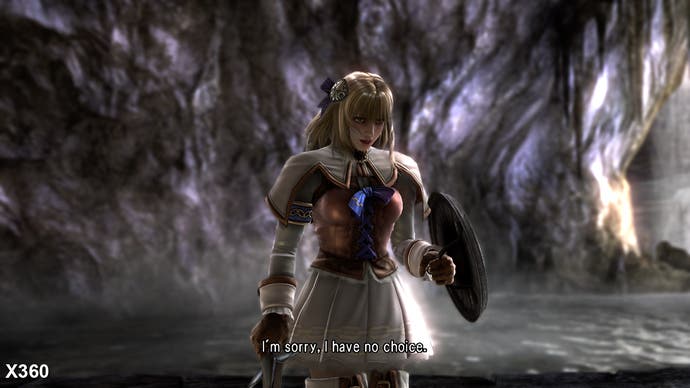
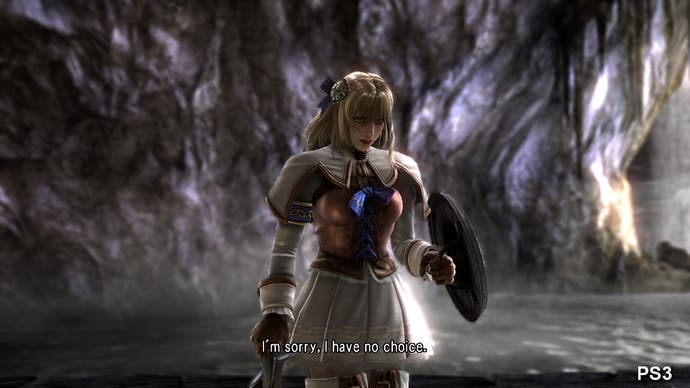
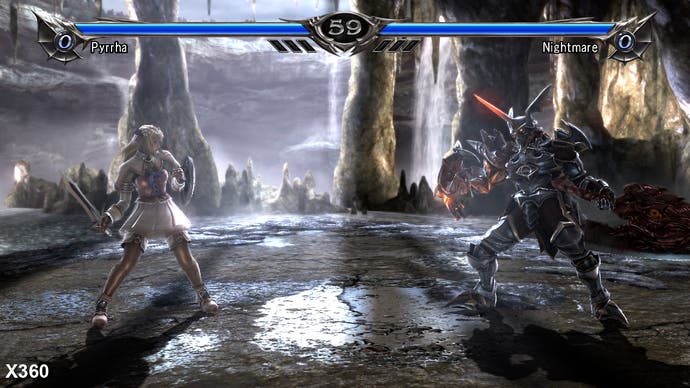

"The consistency between the two platforms extends to the performance - anyone looking to separate the two games based on frame-rate is likely to come away disappointed."
The characters themselves are also gorgeous: SoulCalibur 5 offers a mixture of 30FPS movie cut-scenes encoded using the Criware library, along with 60FPS pre-fight animations using the game engine itself. In both scenarios, the fighters are basically a match - the level of detail is terrific and aside from some low-poly clothing, the characters look as good running in real-time as they do when rendered as offline CG. As for the quality of the FMV itself, it's almost pristine, actually requiring us to turn up the brightness and contrast on the display to see the telltale DCT artifacting that separates a video encode from in-engine rendering. As you may have gathered from the very similar disc sizes, the quality of the FMV is essentially like-for-like, strongly suggesting that the same video encodes have been used on both versions of the game.
In terms of loading times, just like its predecessor, the Xbox 360 has a minor advantage here but the good news is that just the PS3 version features an optional install that dumps the majority of the game data on the hard drive, narrowing the gap. There's no such facility on the Xbox 360 game of course: Namco relies on the OS-level install function instead to do the same job.
Anyone looking to split the two versions of the game based on its performance is also likely to come away disappointed. SoulCalibur 5 delivers 60 frames per second on both platforms, never wavering during gameplay, ensuring that the game looks consistently fantastic and that response from the controller is reassuringly consistent. As you'll see from the videos (we've produced one per platform since head-to-head gameplay doesn't really make sense), the game isn't operating at a locked 60FPS, however - frames are dropped when special moves are activated and the view zooms in for a more dramatic effect. However, it's safe to say that you'd need superhuman senses to detect any drop in the game's refresh.
None of this is really of any importance to the gameplay because the player isn't in control during these spectacular sequences. Both versions seem to operate in the same manner, though in our sample tests, the 360 seemed more prone to inserting the odd duplicate frame. However, as the 60FPS encodes on this page demonstrate, the chances of the human eye picking up on the dropped frames is somewhat remote.
"Debate rages among fighting game fans about latency differences on the two platforms, but our tests indicated that SoulCalibur 5 was once again a match on both systems."
Kept away from the analysis tools and subject to the human eye only, the bottom line is that in every way that matters, SoulCalibur 5 delivers an ultra-smooth experience whether you're playing on Xbox 360 or PlayStation 3, meaning you can purchase either knowing you're getting a top-end experience. Put simply, this one is one of the closest cross-platform games we've ever played.
The question of response is an interesting one though. Every so often, we'll receive mail asking us to test the controller latencies of the big fighting games, the suggestion being that one or other of the platforms enjoys a small latency advantage.
To test this out, we used our Ben Heck latency controller monitor boards, which light LEDs when buttons are pressed. A 60FPS camera is then used to count frames between the LEDs illuminating and the results of these button presses manifesting on-screen. Display latency is then removed to give us our "final" result. One thing to point out here is that we use wireless controllers here, which in the case of Xbox 360 are reckoned to add 8ms of lag. However, this same setup has return 50ms end-to-end latency results with Borderlands (PC) and Modern Warfare 3 (Xbox 360), so we're going to go out on a limb here and suggest that the latency added by using wireless pads will not affect the results.
In the case of SoulCalibur 5, we found a five-frame latency, equivalent to 83ms, on both systems. The accuracy of the result helped by the training mode, which brings up all user inputs on-screen as soon as they are registered. This isn't quite the ultra-crisp response we would have wanted from a 60FPS game, but then again, SoulCalibur relies more upon consistency in response rather than the lowest possible latency.
All in all, the last few days in the company of SoulCalibur 5 have been thoroughly entertaining, if a little short on surprises - in terms of both gameplay and comparison between the two systems. While there's a legitimate case to be put to the developer that some of the more interesting single-player game modes from the previous SoulCalibur games have been criminally omitted from the HD era offerings, SoulCalibur 5 plays as beautifully as it looks, coming across almost like the game that its predecessor should have been. It's just a shame that the single-player game appears to be regressing when compared to its PS2-era offerings.
However, there's little doubt that of all the core gaming genres, it is the one-on-one fighting game that has seen the least evolution in the transition to the HD console era. The market has become much more of a niche since that Street Fighter II heyday, and there's a palpable sense that none of the existing fighting game developers are looking to challenge the core fanbase with something new or radically different from what they've played before.
"Core gameplay hasn't changed so much over the years. There's a palpable sense that none of the existing fighting game developers are looking to challenge the core fanbase with something new or radically different from what they've played before."
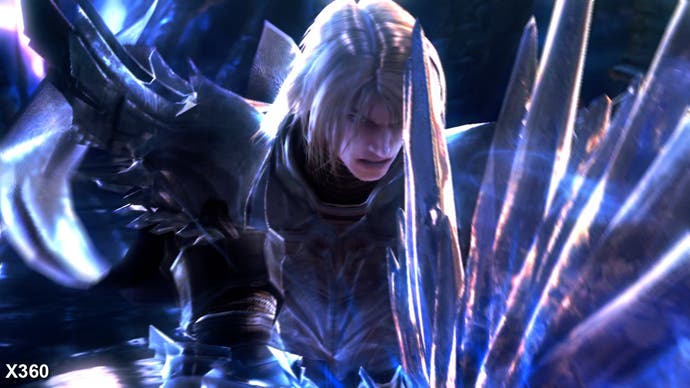

The brief flirtation we saw with environmental interaction in Virtua Fighter 3 turned out to be a blind alley, and after negative feedback from the core fanbase, was never seen again in either of its sequels. Even the transition from sprite-based 2D to polygon-driven 3D has only really seen a superficial level of additional gameplay potential: at the end of the day, it's still about the characters playing out the exact same moves to the exact same inputs with zero variation, regardless of where they sit in the game world or what is happening around them. Street Fighter 4 - for all its brilliance - is effectively mapping the original 2D gameplay into a 3D engine.
EA's attempts with its Impact Engine in the latest FIFA - in physically mapping the way the human body moves - is an intriguing experiment (albeit one with often unintentionally hilarious consequences) - and you can't help but wonder if there's a germ of an idea here in how the fighting game could evolve, using an engine that maps how the human body moves and reacts to what is happening around it. Couple that with dynamic, interactive environments and that's a next-gen fighting game we'd love to play...




